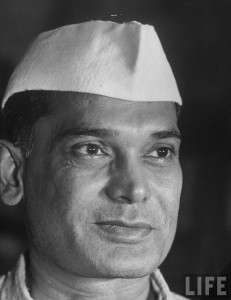Gandhi, Vinoba, and the Bhoodan Movement
by Jayaprakash Narayan
The Bhoodan movement aims not only at establishing world peace but also at creating the foundations of a peaceful life. Although everyone is interested in the problems of peace, very few stop to question what the sources of human conflict may be, and why it is that in human society there is strife of every kind including war.
Mahatma Gandhi was an exception in that he tried to go to the root of this problem, and he built up a philosophy of life based on what he called truth and nonviolence. In building up his philosophy he took help from wherever he could. It is well known how deeply indebted Gandhi was to Jesus, and how he always considered the Sermon on the Mount to be his greatest single inspiration. The philosophy of turning the other cheek was the foundation of his whole satyagraha movement, first developed in South Africa in 1906, and then in India. Among modern thinkers, he acknowledged Tolstoy, Ruskin and Thoreau to be his teachers. Whatever he tried to do, he did with an open mind; nothing was foreign to him just because it happened in a foreign country. He was what might be called a universal personality.
Gandhi applied his philosophy of satyagraha to the Indian freedom movement. I also was one of his humble soldiers and like so many Indians of those days I had to spend several years in prison. During those years, the freedom fighters had to go through all kinds of suffering, of which I think imprisonment was perhaps the least noxious. But travellers to India today are surprised to find that there is no ill will or bitterness anywhere for Britain or for the British people but, rather, a very warm welcome.
Read the complete pdf of the article by clicking here: Gandhi, Vinoba, and the Bhoodan Movement.
Reference: IISG/WRI Archive Box 108: Folder 2, Subfolder 4.
Glossary:
Bhoodan was a voluntary donation by landowners of a portion of their land to the indigenous poor, who could not become self-sufficient on their own small plots. This Land Gift Movement was started by Vinoba Bhave in 1951, and marks a significant application of Gandhi’s Constructive Programme to wealth distribution. Most often title of the donated land parcel was turned over to the local village council for management.
Gramdan was the extension of the land grant concept to villages, which would make a declaration that they agreed to the principles of Bhoodan outlined by Bhave. As noted in the article above there was an attempt to extend the concept to Indian districts and states.
Sarva Seva Sangh was the organization or movement whose members attempted to carry out the principles of Sarvodaya, and acted as a nonviolent, voluntary welfare group.
Sarvodaya means “self-determination”, or “uplift”. Gandhi coined the term in 1908 as the title for his Gujarat translation of Ruskin’s Unto this Last. Later nonviolent leaders such as Vinoba Bhave used it to denote the social nonviolent movement itself, and saw it as an extension of Gandhi’s constructive program, and the most important use of the philosophy of nonviolence in India.
Shanti Sena means literally “peace army”, and has been variously referred to as the Nonviolent Peaceforce, or the World Peace Brigade. Gandhi coined the term near the end of his life, as he was trying to rally a voluntary nonviolent peacekeeping force to halt and prevent communal violence between Hindus and Muslims, especially in northern India.
For further information about the above terms please consult our Constructive Programme category, especially the articles posted there by Mark Shepard. Shepard’s bibliographies, at the end of his articles, are helpful beginning points for further research. There is an extensive literature on each of the above terms, including important works by Vinoba Bhave (see the cover illustration reproduced above) and Thomas Weber. We might also recommend Geoffrey Ostergaard and Melville Currell, The Gentle Anarchists: A Study of the Leaders of the Sarvodaya Movement for Nonviolent Revolution in India, Oxford: Clarendon Press, 1971, a very astute study of the movement, which has hardly been bettered.
EDITOR’S NOTE: Jayaprakash Narayan (1902–1979), popularly referred to as JP, was an Indian independence activist, social reformer and leading Indian socialist, remembered especially for leading the mid-1970s opposition against Prime Minister Indira Gandhi. In 1922 he went to the US to study at the University of Wisconsin, working as a fruit picker, jam packer, waiter, mechanic and salesman to pay his tuition. During his studies Narayan was influenced by Marxism, although he was opposed to policies of the Soviet Union and rejected organized communism upon returning to India in 1929. He was appointed secretary of the Congress Party, whose leader was Jawaharlal Nehru, and later became the first independent Indian prime minister. In 1934, Narayan led other Marxists in the formation of a Socialist group in the Congress Party. Please consult this site for more thorough biographical information.





